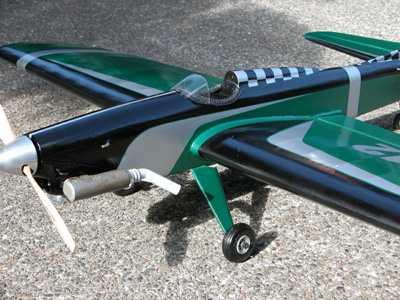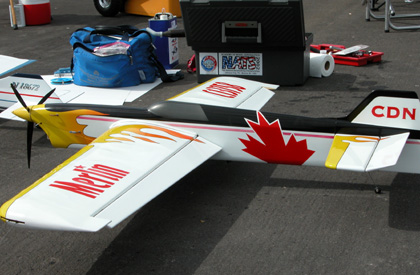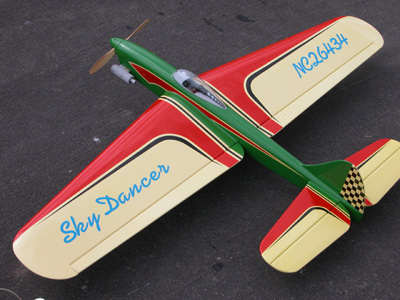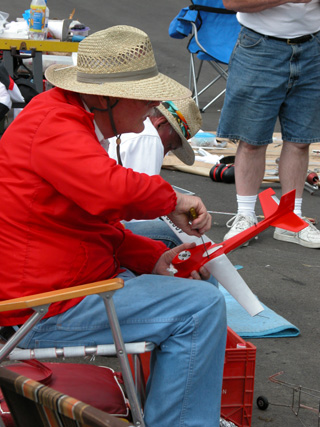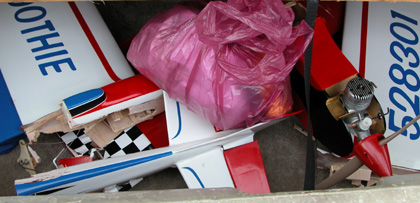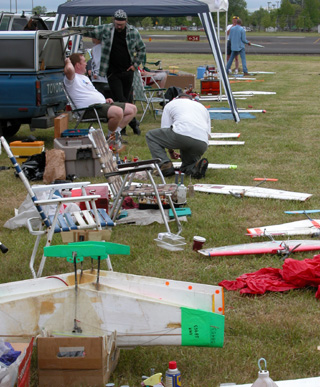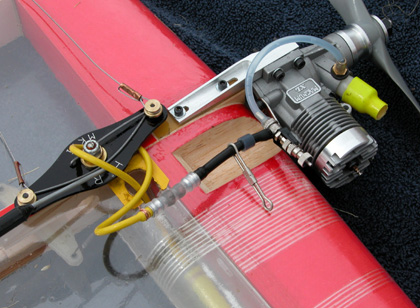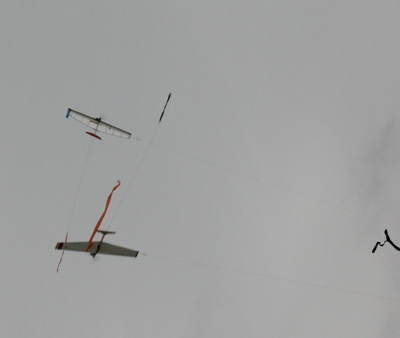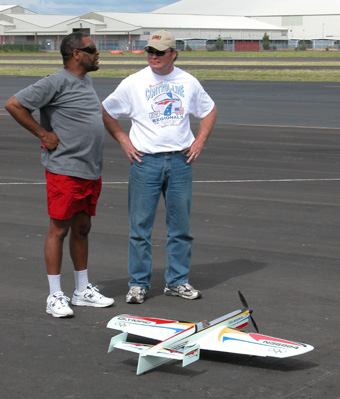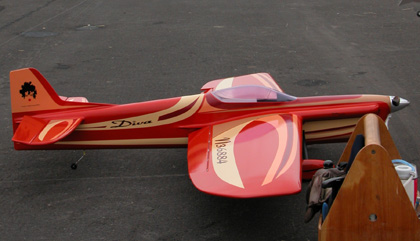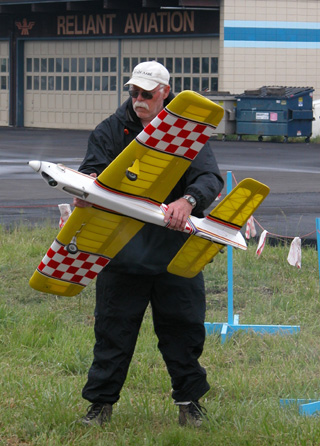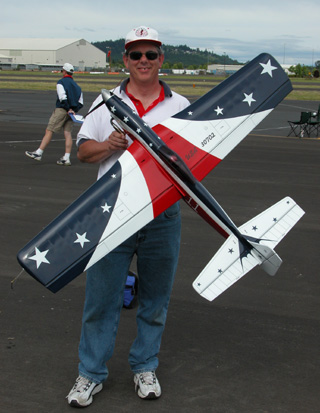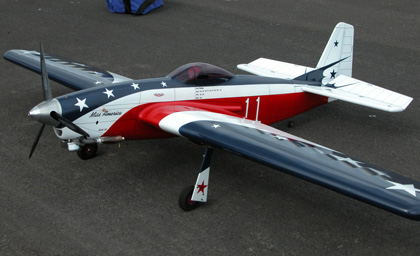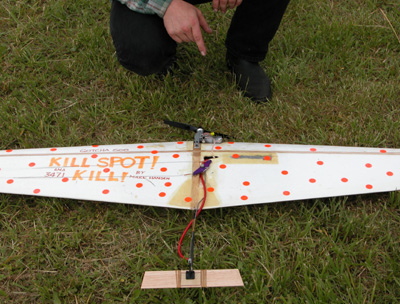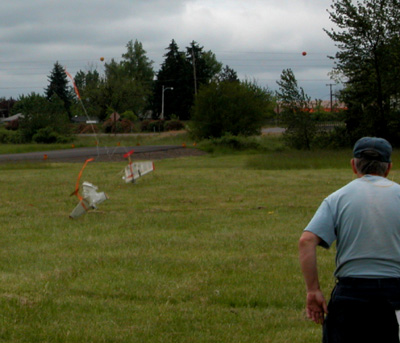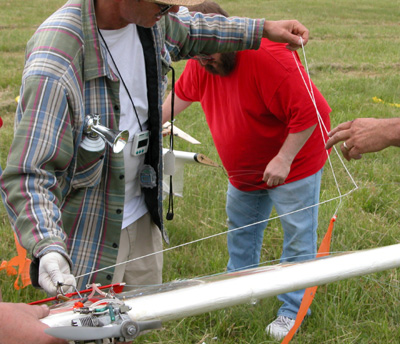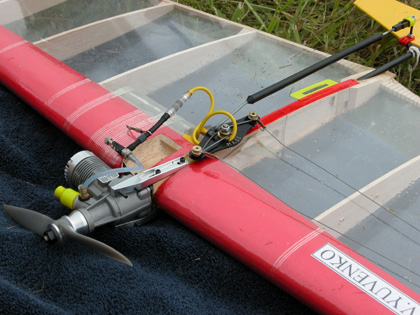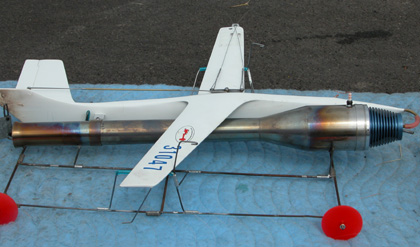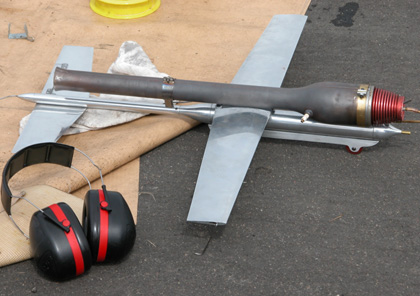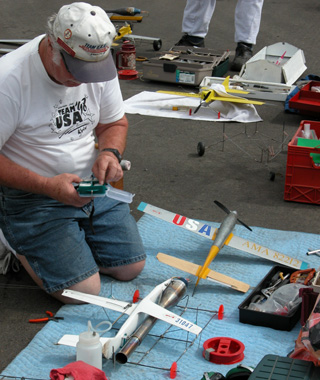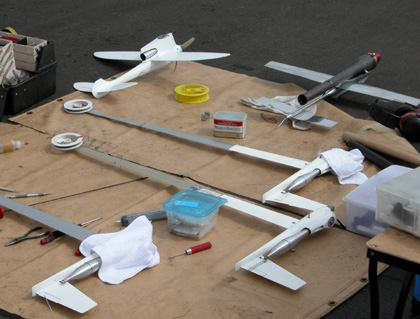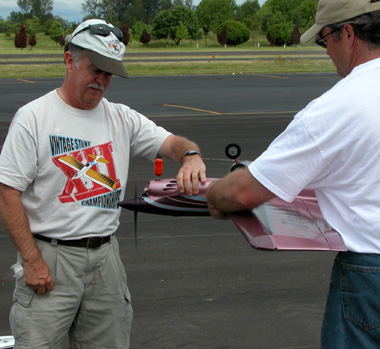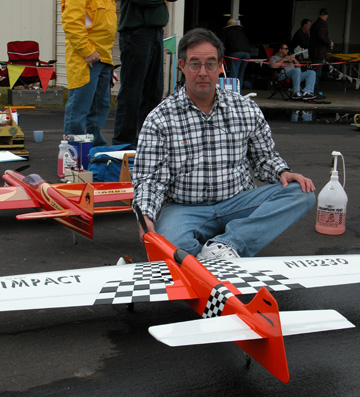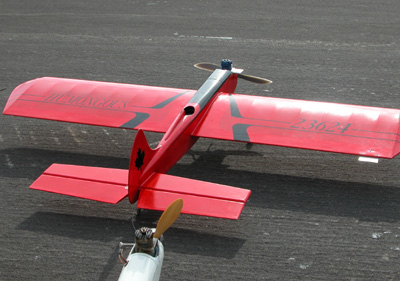|
It was Memorial Day weekend in
2003, but rather than stay home and work in
the garden with Satomi I decided to steal the weekend for myself and go to
Albany, Oregon for the control line model aircraft regional championships. This particular contest
was sort of a goal I set when I started building model planes again back in 2001.
My Thunderbird classic stunt model (designed by Bob Palmer)
I
don't really know why I wanted to drive all that way to complete in a model
contest. If I think about it rationally
there's no reason to add the stress of competition to an otherwise relaxing and
harmless hobby. But there's a lot of life packed into any kind of contest. Many hobbies and recreations have organized contests, everything from fencing and swimming,
to dog and flower shows. At their core these events, and in particular those obscure ones where there is
little or no possible commercial gain to be had from winning, are much the same,
and you have people who take them seriously to greater or lesser degrees. And
you have a natural, human desire to do well, or at least to avoid embarrassing
yourself. So over time you learn skills, and you learn to be prepared. These are
good life
lessons in general.
Part of the "Dreaded Canadian Contingent"
I think being involved in this stuff as a kid helped
me to be a problem-solver. I may be sloppy and unprofessional in general (I'd be
a terrible lawyer or doctor, and I'm not a particularly good
project manager) but I think I know, more intuitively than most, how to fix
things.
"Sky Dancer" classic model So I went to Albany Airport in Oregon. The drive
down from Kirkland was an easy four-plus hours, with lots of time to think when
driving. I remember having brilliant thoughts the whole way and almost passed
the Albany exit mid-thought, but I neglected to write any of them down. Lost
forever are two novels, a new marketing strategy for my company, and a hundred
or more keen and insightful observations for my journal.
Title this one: Old men and Nitro (nice colors)
After arriving I pulled
out my gear and started working with my Thunderbird stunter to get it ready. The
weather was hot (into the 80s) so the plane flew quite differently that I was
used to... and not
very well. One old geezer scratched at his stubbly chin and said not very
helpfully, "well, I'm not sure that thing will even do a wingover...". I
switched to a prop with more pitch and it was even worse. Scott Riese (a very
helpful guy I knew, but until this event only via email) was also getting his
classic stunt plane ready and he suggested I try a smaller, fatter and
hand-balanced prop that he had. It make a big difference, the motor revved up
great with his prop and I had my power back.
Scott Reise sadly took home a trunk load of plane parts
After getting the T-bird running the way I wanted I
went over the combat area and messed around with my gear. The motor
ran well and the speed clocked in at just under the limit (80MPH) for the
event.
Combat: the bad boys, banished to the farthest end of the field
Combat model engine and control installation.
The next morning I got up early -- I couldn't sleep anyway -- and went back
to the airport. I was one of the first in line at the practice circle and got
one flight with the Thunderbird. I had no problem there, it was much cooler weather
and the motor ran well, so I drove over to the combat field. I had three
hours of fun, mostly watching other matches, getting my equipment ready and
helping others as pit crew, until I was eliminated in the third round by a 13
year old kid whose family owned a
yappy little dog named "Dave". The family kept yelling at the dog, as in "Dave! Stop that
and get over here! Dave? Where are you Dave?"...
Combat action
Phil Granderson and Bruce Hunt with Phil's classic Olympic model (I hadn't seen Phil Granderson since I was a kid. He barely remembered me, but he was one of the top combat fliers at the time and was always willing to help me out at contests. He would look at my awful gear and say things like, "OK... I'll start it, but then I'm gonna run...")
Phil Granderson's "Diva"
When I got back to the hotel (after a really awful
"hanger feed" of fried chicken and beans, listening to old geezers talk about
head clearances and castor versus synthetic oil) Satomi called from the
neighbors' garden. They were having a great party. Man did I want to be there
rather than in the Holiday Inn Albany. But I took a shower, went again into town
for a salad, got to bed early and actually got a little sleep. In the morning I
felt better, particularly after the precision aerobatics event got
started.
"Joe Bellcrank" tunes up his Russian Stalker motor
"Joe" (John, actually) crashed the plane pictured above during a practice session on Sunday. He cut an outside square loop too low (the bottoms of the loops are supposed to be five feet off the deck, he seemed to be trying for five inches instead). The plane bounced, sheered off its canopy, rudder and prop but somehow he manhandled it around in a half loop to land dead-stick on its wheels. Minimal damage considering it was a full power, inverted touch-and-go on pavement. My first flight was something of a bust because I left out one measly inverted lap (I needed to do a minimum of six and I guess I counted wrong) and lost the pattern points. The second flight was better, I scored 414 which is a decent intermediate score. And one expert who was watching encouraged me by saying the best maneuvers I did were after the judged pattern was finished and I was relaxing with some gentle loops and squares (he said, "two of us looked at those pretty outside loops and we thought, 'well, where did those come from?'").
Paul Walker (many-time U.S. stunt Champion) with his Mustang
Paul's Mustang: exquisite details
Event details follow: Combat The goal of a combat event is, within a five minute match period, to either accumulate more points than your opponent (one point for each second in the air, and 100 points for each cut on the colored streamer) or kill your opponent outright by cutting the string leader that attaches the streamer to the other plane. The events flown at Albany were speed limit combat (no faster than 80MPH) and 1/2A, which has an engine size limit. I flew the speed limit event, which is less costly due to a wide variety of cheap, available engines. (Fast combat, which is now flown mostly at special "big money" events, has an engine limit of .36 cubic inch but no speed limit. Speeds in fast combat routinely exceed 125 MPH. That's very, very fast.)
"Kill Spot! Kill!" 80MPH speed limit combat plane
Here's a terrific sequence I managed to capture by shooting almost non-stop stills with the digital camera: These two planes are each going close to the 80 mile per hour speed limit. Lots of close quarter combat going on, they have each scored a cut on the other:
Combat action: one cut each, and a near-collision
Then with a CRUNCH they collide, one motor starts screaming with its prop sheared off and both fall to the ground:
After a mid-air, both come down mortally wounded Jeff (the judge) examines the wreckage to determine if either plane is flyable, and whether either of them scored a kill on the other in the wreck. No possibility of either going back in the air safely, and he determines that both string leaders are intact. They each have one cut so the match is won on airtime: whichever plane got in the air first at the starting horn has won.
Jeff does a post-mortem (the surgical glove is a nice touch). Both are dead, but no kill!
My speed limit combat setup Above and below are pictures of what I put together for the speed limit event. The airframes are FAI (international class) ready-to-fly models built by a guy in Ukraine (Yuvenko) and imported by a guy in Louisiana. Because the speed in this event is greater than 75MPH, the AMA (sanctioning body for model aviation contests in the U.S.) requires that fuel shutoff devices be employed. These I got from Jeff Rein, the judge in the previous picture, who happens to live in Kirkland. Jeff and his friend Tony designed and manufacture the shutoffs, and they are rather clever little things that instantly cut the fuel supply if there is any loss of line tension after the initial launch, such as would be the case if the control lines got cut or if there was a loss of control and the plane decided to come after its pilot's head. To make it all work I had to strip out Yuvenko's internal control system and mount Jeff's combination shutoff/bellcrank externally. I also replaced the wire elevator pushrod with one made from an arrowshaft (less likelihood of bending). Finally, the motor mounts were shimmed wider allowing a .25 engine (a Chinese-made Magnum R/C sport motor with the carb removed and replaced by a nylon venturi that I fashioned out of a spacer I found in the nuts and bolts section at Home Depot) to be installed in place of the normal .15 used in FAI combat. The fuel is fed from a high-pressure bladder system through the shutoff, via the thin yellow tube, through a filter and remote needle valve (Japanese, from an OS Max motor) to a fitting I drilled and tapped a hole for in the side of the old carb mount. Whew! That all sounds complicated but there isn't more than $150 in materials in the whole package, including the new-in-the-box motor, and everything is reusable again and again except for perhaps a few dollars worth of wood, foam and covering that would be "re-kitted" in a crash or mid-air... ...assuming, of course, I ever enter this event again. I'm not sure the fifteen minutes of thrill (I only lasted three rounds) was worth all the work. But the planes are fun to fly even without someone on your tail. I'll take them up to Arlington once in a while.
Close-up of the engine modifications. The fat yellow cover on the venturi is a "dork tube" that helps keep dirt out of the motor in a crash. Speed...I've never flown speed events, but they are wild to watch. Imagine a little plane, no bigger than a dinner plate, screaming around the circle at 200MPH. I watch these guys -- you can't help turning and watching when a pulse jet starts running -- but I can't comprehend how they do it, or why...
Sport Jet class (don't ask me what that means, but the owner of this jet told me they don't go more than about 150MPH)
Another sport jet... and those better be good ear protectors, because those jets are LOUD
His shirt says "Team USA, 1998 Kiev". I'd like to watch him come back through customs from the former evil empire with that jet packed in his luggage!
These are the fast ones. FAI (international) speed. A speed guy described the "state of the art" to me on Saturday. Look at the previous picture. There are three FAI speed planes lying there. The international rules require a certain amount of wing area, so the designers figure, OK... the wing on the inside of the circle goes a little bit slower, hence less drag... so we'll extend the inboard wing as far into the circle as practical and remove the outboard wing entirely. They also figured out that a 2-blade propeller spinning at 40,000(!!!) RPMs will not be efficient because each blade disturbes the air that the other has to go through. So they eliminate one blade and counterbalance the shaft. Finally they add a tuned pipe to the exhaust to boost power to around 2.2 horsepower. (Do the math: if the V6 engine in your Honda Accord put out the same power per cubic inch as one of these little motors your car would have 2,640 horsepower instead of a measly 150.)
Stunt...Speed and racing were on one end of the field, combat was way, way down on the other end, and in the middle was the sport of gentlemen: control-line precision aerobatics. Beautiful models, and more than 40 contestants flying three different events (Old Time, Classic and Precision Aerobatics). I flew my classic-legal (1959 design) Thunderbird in two events, did really badly but didn't break the plane, which is more than a couple of others can say. I was totally outclassed, but I guess I knew I would be...
Pat Johnston
Howard Rush (Paul Walker-designed Impact stunter)
Old Time Stunt model ("Humongous", designed 1949)
|
